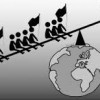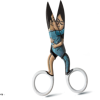Interesting questions raised on singularity, its risks and some immediate cultural issues around it.
Category Archives: news
“Digital tattoo lets you control devices with mind power alone” by Hal Hodson
It’s been a while we know electroencephalograms give information on what is happening inside our brains. But it’s not something you’d want to be getting around in your head – or is it?
John Rogers at the University of Illinois at Urbana-Champaign led the team that built a flexible electronic skin that conforms to the body, which is so light that it sticks to the skin through van der Waals force – the same mechanism that lets geckos’ feet stick to surfaces. It only falls off when the build-up of dead skin beneath it makes it lose its grip.
“The Coming Problem of Our iPhones Being More Intelligent Than Us” by VIVEK WADHWA
“Ray Kurzweil made a startling prediction in 1999 that appears to be coming true: that by 2023 a $1,000 laptop would have the computing power and storage capacity of a human brain. He also predicted that Moore’s Law, which postulates that the processing capability of a computer doubles every 18 months, would apply for 60 years — until 2025 — giving way then to new paradigms of technological change.
Kurzweil, a renowned futurist and the director of engineering at Google, now says that the hardware needed to emulate the human brain may be ready even sooner than he predicted — in around 2020 — using technologies such as graphics processing units (GPUs), which are ideal for brain-software algorithms. He predicts that the complete brain software will take a little longer: until about 2029.
The implications of all this are mind-boggling…” read full story
“Online Fact-Checking Tool Gets a Big Test with Nepal Earthquake” – By Mike Orcutt
An organization crowdsources the verification of rumors on social media in the Nepal disaster zone.
Shortly after a 7.8 magnitude earthquake hit Nepal on Saturday, social media services lit up with unverified reports of people trapped and buildings damaged. But how could humanitarian organizations know where to respond first? How could they know which accounts were actually true? – Read story from MIT Technology Review…
It’s Time for a Conversation – by Joshua Foer
“Breaking the communication barrier between dolphins and humans
When a chimpanzee gazes at a piece of fruit or a silverback gorilla beats his chest to warn off an approaching male, it’s hard not to see a bit of ourselves in those behaviors and even to imagine what the animals might be thinking. But dolphins are something truly different. They “see” with sonar and do so with such phenomenal precision that they can tell from a hundred feet away whether an object is made of metal, plastic, or wood. They can even eavesdrop on the echolocating clicks of other dolphins to figure out what they’re looking at. Unlike primates, they don’t breathe automatically, and they seem to sleep with only half their brains resting at a time. Their eyes operate independently of each other. They’re a kind of alien intelligence sharing our planet—watching them may be the closest we’ll come to encountering ET.
Dolphins are extraordinarily garrulous. Not only do they whistle and click, but they also emit loud broadband packets of sound called burst pulses to discipline their young and chase away sharks. Scientists listening to all these sounds have long wondered what, if anything, they might mean. Surely such a large-brained, highly social creature wouldn’t waste all that energy babbling beneath the waves unless the vocalizations contained some sort of meaningful content. And yet despite a half century of study, nobody can say what the fundamental units of dolphin vocalization are or how those units get assembled.
“If we can find a pattern connecting vocalization to behavior, it’ll be a huge deal,” says Kuczaj, 64, who has published more scientific articles on dolphin cognition than almost anyone else in the field. He believes that his work with the synchronized dolphins at RIMS may prove to be a Rosetta stone that unlocks dolphin communication…” read full story in National Geographic
“The Cities Science Fiction Built” by ADAM ROTHSTEIN
“The opening credits disperse, revealing a city. What city? A future city. This is an SF film, and we may not yet know the rules of this speculative world—whether there are space colonies, or authoritarian governments, time travel, or amazing future weapons—but we are already getting a taste through the thick world-building of the urban setting. Through the smogged out skies and the burning rubbish bins, or conversely, the spotless flying cars and the gleaming spires of impossible structures, we learn what kind of fictional world into which we have been dropped.
But these fictional cues are not all ray gun fantasies. Much of our depiction of future cities is taken from our non-fictional world, from our real cities that we must live in on an everyday basis. It is in this world where our speculation comes home to roost. Our ideas for the future of the city are of course born in the present…” featured in Motherboard
Ethylic Charms – low dose alcohol increases facial attractiveness
Drinking will make other people more attractive. Careless attitude toward danger also have encouraged riskier sex.
New research now bring light to a positive effect that “In addition to perceiving others as more attractive, a mildly intoxicated alcohol consumer may also be perceived as more attractive by others.”
That’s right. Not only they look better – you do too! Now before you celebrate keep in mind so far this is only valid for low doses. Not all good news…
new GMO might provide less carcinogen french fries
Recent technique for genetic editing made possible by ‘knock-out’ targeted genes.
In this case, researches inacvtivated a single endogenous gene in potatoes that are deemed responsible for sugar accumulation at cold storaging.
Such potatoes, once fried, would produce lower levels of acrylamide, a suspected carcinogen.
“A Swiss Army Knife for Neuroscience” By Antonio Regalado
From MIT Technology Review:
Neural probes that combine optics, electronics, and drugs could help unlock the secrets of the brain.
Various powerful new tools for exploring and manipulating the brain have been developed over the last few years. Some use electronics, while others use light or chemicals.
At one MIT lab, materials scientist Polina Anikeeva has hit on a way to manufacture what amounts to a brain-science Swiss Army knife. The neural probes she builds carry light while collecting and transmitting electricity, and they also have tiny channels through which to pump drugs…
“Machine Dreams” by Tom Simonite
…In today’s era of smartphones and cloud computing, HP’s core products could also look antiquated before long. Revenue and profit have slid significantly in recent years, pitching the company into crisis. HP is sustained mostly by sales of servers, printers, and ink (its PCs and laptops contribute less than one-fifth of total profits). But businesses have less need for servers now that they can turn to cloud services run by companies like Amazon—which buy their hardware from cheaper suppliers than HP….
HP has shed over 40,000 jobs since 2012, and it will split into two smaller but similarly troubled companies later this year (an operation that will itself cost almost $2 billion). HP Inc. will sell printers and PCs; Hewlett Packard Enterprise will offer servers and information technology services to corporations. That latter company will depend largely on a division whose annual revenue dropped by more than 6 percent between 2012 and 2014. Earnings shrank even faster, by over 20 percent. IBM, HP’s closest rival, sold off its server business to China’s Lenovo last year under similar pressures.
And yet, in the midst of this potentially existential crisis, HP Enterprise is working on a risky research project in hopes of driving a remarkable comeback. Nearly three-quarters of the people in HP’s research division are now dedicated to a single project: a powerful new kind of computer known as “the Machine.” It would fundamentally redesign the way computers function, making them simpler and more powerful. If it works, the project could dramatically upgrade everything from servers to smartphones—and save HP itself…. Read full story..
“Here’s How We Can Reinvent the Classroom for the Digital Age” by Vivek Wadhwaon
article from http://singularityhub.com/
“When I was in elementary school, about 50 years ago, teachers used to stand in front of a class of 40 or 50 children and write on a blackboard with chalk. To make sure the material was absorbed, the teacher asked occasional questions and assigned lots of homework. If students discussed their homework or helped each other in tests, it was called cheating, and they were punished.
Today, the blackboard has become a whiteboard; chalk has become a magic marker; the slates that students used have been replaced by notebooks; and classes have sometimes gotten smaller. Little else has changed. True, some schools are providing their students with laptops, and teachers are increasingly using technology and encouraging collaboration. But the methods are essentially the same—with the teacher dictating learning.
What is becoming possible, however, is a revolution in education. I am not talking about the much-hyped Massive Open Online Courses. To me, these are as imaginative as the first TV shows in which radio stars stood in front of a camera with a microphone in hand. I am talking about a complete transformation of the way teaching is done, with the computer taking the role of the lecturer, the teacher becoming a coach, and students taking responsibility for their own learning.
The digital tutor of the future will do knowledge transfer better than a human can. If the student likes reading and lectures, it will teach in a traditional way — through eBooks and videos. If not, it will teach through games, puzzles, and holographic simulations. What better way to learn history, culture, and geography than by being there virtually and experiencing it?
In the future I am talking about, the role of the human teacher is that of guru: to teach values such as integrity, teamwork, respect, caring and commitment; to be a guide and mentor. And students take ownership of their education. This future isn’t as far away as you think. I’ve already seen early signs of it in Silicon Valley.
Esther Wojcicki, who is a teacher at Palo Alto high school, has been pioneering a new method of learning for the past 30 years. She joined the faculty at Palo Alto in 1984 as a teacher of English and journalism. She had a Master of Arts in journalism from UC Berkeley’s Graduate School of Journalism and had worked previously as a reporter. When she arrived, there were 19 students in the journalism program, publishing a bimonthly eight-page newspaper that they created on a typewriter, pasted up with hot wax, and printed using hot-metal typesetting.
In 1987, Wojcicki saw a demo of a Macintosh at a small store in Los Altos and got excited about the possibilities for her classroom. She applied for a grant from the state of California to buy seven Macs and was selected. When the computers arrived, though, she had no idea how to even turn them on. Not having anyone to help her, she turned to her students, admitted that she “had no idea what she was doing,” and asked for their help. Wojcicki says that this was the beginning of a collaborative learning model of teaching that she has since been refining.
Fast forward to 2015, when the country is adopting a pedagogy that focuses on personalization, collaboration, innovation, and creativity. Palo Alto High School has a 25,000-square-foot Media Arts Center, with 600 students who use media to learn critical-thinking skills, communication skills, and tech skills. And by the way, they are also perfecting Common Core State Standards skills. This is a program to teach students to think critically and be prepared for the unknown future; it is not focused on training journalists. The school has six publications: a 28-page full-sized student newspaper, The Campanile; a news magazine,Verde; a sports magazine, Viking; an arts and entertainment magazine, C Magazine; a broadcast television program, InFocus; and a website program,voice.paly.net.
In a new book, in which, with co-author Lance Izumi, she shares her experiences, Wojcicki says that Google-style moonshots are necessary to transform education. Wojcicki and Izumi advocate changing the culture of the classroom so that the teacher relinquishes some control of the learning to students and the lessons become more relevant to the real world. Here are some of the key lessons from their book, Moonshots in Education: Launching Blended Learning in the Classroom.
Giving students some control of their learning is the key to engagement. Whilst that sounds simple, in fact it requires a moonshot, because schools of education train teachers to always maintain control, so one of the scariest things for teachers is to give up any control to students. They are worried that they will be evaluated on “loss of control” in their classes, and that the test scores will fall, for which they will be blamed and lose their jobs. They do not want to take a risk.
If we want to train a generation of innovators, then we need to give them an opportunity to be innovative in school. If we want to train a group of people to obey orders and not think for themselves, then we should continue with traditional education. The old model was developed more than a 100 years ago to train workers for the factory.
Students do well in classrooms when they are treated with trust and respect. Everyone, especially a child, wants to feel important and empowered. All classrooms should treat students with kindness, trust, and respect, giving them an opportunity for innovation and collaboration. The culture of the classroom is the key to getting kids excited about learning.
Mastery of learning is also important. Children need an opportunity to redo assignments until they learn the material. Some people take longer than others to learn, but that does not mean that they are inferior or cannot learn. Grades can be an inhibiting factor: students who get a bad grade don’t want to do the assignment again; they get discouraged. But if they just get the corrections, with instructions to revise (the same instructions everyone else gets), they will do the work. They all want to succeed.
This methodology can be used in all subject areas. If students were given as little as 10 percent of the time to work on a project of their choosing, they would be more excited about learning the subject matter. Wojcicki says that 50 percent of the time should be dedicated to blended learning.
The digital tutor I described is probably five or 10 years away, but it is coming. In the meantime, there is nothing to stop us from adapting education to the modern era of creativity and innovation — and taking advantages of technologies that are already here.”
“Cruise Control for Pedestrians” Max Pfeiffer, Tim Dunte, Stefan Schneegass, Florian Alt, Michael Rohs
If only Thales of Miletus had this on…
Researchers from Universities of Hannover, Stuttgart and Munich in Germany propose a navigation system that remove intermediaries and goes straight to our muscles to tell them which way to move.
One way we can see this applied is on precise exercising or situations where our sensorial capabilities lack precision such as low visibility. And many other uses would come along, not the least for people whose health and safety would greaty benefit from it.
Yet in a world in growing competition of our limited visual awareness, this could well be a step towards freeing this highly demanded information channel. One would not need to loog to a map to find it’s way to the store. Stores would drive consummers to itself while consummers can watch their new favorite marketing embeded entertainment.
Could distributed consensus systems replace global currencies (even Bitcoin)
Stanford professor David Mazières published in a white paper on April 8th a system that proposes a new approach to consensus.
Federated Byzantine agreement (FBA) in general relies on quorum slices and individual trust decisions that together determine system-level quorums. Slices bind the system together much the way individual networks’ peering and transit decisions now unify the Internet.
The publication also presents the Stellar Consensus Protocol (SCP), a construction for FBA. SCP makes no rational behavior assumptions, yet unlike prior Byzantine agreement models, SCP enjoys open membership. Compared to decentralized proof of-work and proof-of-stake schemes, SCP has modest computing and financial requirements, lowering the barrier to entry and potentially opening up financial systems to new participants.
SCP’s four key properties are: Decentralized control; Low latency; Flexible trust; Asymptotic security.
Practical application and public acceptance of SCP as a currency platform is not clear, but it does show some progress over some reported issues with Bitcoin.
There is also a handy summary available if you wait and see how market embraces SCP before going through whole paper.
“Wiring the world below” – The Economist
“The planet arrogantly dubbed “Earth” by its dominant terrestrial species might more accurately be called “Sea”. Seven-tenths of its surface is ocean, yet humanity’s need to breathe air and its inability to resist pressure means this part of the orb is barely understood.
In June a project designed to help correct that will open for business. The seven sites of the United States’ Ocean Observatories Initiative (OOI), scattered around the Atlantic, Pacific and Southern oceans, will measure physical, chemical, geological and biological phenomena from the seabed to the surface…” article from The Economist
IBM’s Rometty on Health Care as IBM’s Moon Shot
Interestingly, as pointed our by Business Insider’s Julie Bort, Ginni Rometty refers to Watson as ‘he’.
As pointed out, among others, by Daniel Dennet, such reference might imply in an upgrade in granted status of Artificial Intelligence and computer’s minds.
One would rather trust a phisician with a mind, no doubt. Whether Watson’s handwritting will keep tradition or raise the bar remains unclear…
Airware platform pitch for industry operating system
Combining hardware, software and cloud services, the Aerial Information Platform purpose is to help companies to meet insurance and government compliance requirements, quickly customize, and safely operate commercial drones at scale.










